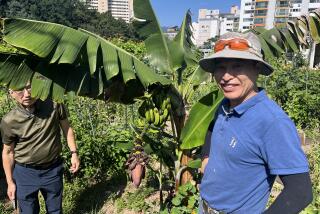Fiddle Pickin’ : Scores of People Trek to Forest to Harvest Fern Used in Asian Dishes
- Share via
LAKE ARROWHEAD, Calif. — There is hunting season and there is fishing season, and on Saturday, Seung and Chung Song and their family celebrated the opening of fern-picking season.
With sacks in one hand and gloves on the other, the Songs joined scores of other Koreans from the Los Angeles area who scoured the grassy hillsides at 5,000 feet in search of tiny green shoots that, later this year, will grace their most special dinners as a vegetable side dish.
Their prize is fiddleheads, the tender young shoots emerging from the ground that if left unpicked would lay a blanket of fully leafed green bracken ferns.
The summer’s ferns may appear to the uninitiated as little more than attractive ground cover, but these new spring shoots are culinary delights in Asian culture, and one of the places where bracken ferns grow most abundantly is in the San Bernardino National Forest.
Because the plant contains toxins that can cause illness, the fiddleheads must first be boiled and dried. Appearing as crisp twine, the vegetable has a shelf life of several years.
When it is time to eat it, the fiddleheads are soaked overnight, boiled, soaked again in cold water, rinsed and sauteed with onions, garlic, soy sauce and sesame seed oil, resulting in a favored side dish to traditional Korean meals.
On the plate, they look like thin, round, brown noodles, and have a taste and texture similar to asparagus.
Bracken fern fiddleheads--the curly-Q shoots--can be purchased in Korean and other Asian grocery stores for up to $6 or so per quarter pound. Or, you can just come here, buy a permit from the U.S. Forest Service that will let you bag 40 pounds for $10, and pick away.
“It’s worth it,” said Chung Song, who with her husband owns a bilingual secretarial service in Glendale. “Last year we picked enough in two days to last us all year. And it’s fun picking them.”
They search with a keen eye for the shoots poking up through the new grasses. This one is too small; that one is too tall and beginning to unfurl into the fern itself; ahhhhh , this one is just right!
Pluck.
Timing is everything in fern-picking. A fiddlehead that is too short this weekend may be too tall and hard next weekend because they grow so quickly. And ones that are picked as just right will be replaced by new fiddleheads in a couple of weeks, in time for the next swarm of fern pickers.
By the time the fern-picking season is over, final shoots will allow the plant to develop fully as summer foliage.
The tradition of fern-picking was getting out of hand for a time up here; residents complained that flatlanders showed little respect for private property and trod just about everywhere in search of fiddleheads.
So in 1981, the Forest Service restricted fern-picking to selected pastures and began issuing picking permits. Since then, more than 140,000 pounds of fiddleheads were plucked for the dinner table. Last year, 1,530 people picked 16,471 pounds of fiddleheads, based on permit sales.
U.S. Forest Service resource assistant Veronica Magnuson said that in tree plantations in the Northwest, the ferns have to be weeded out because they would otherwise choke seedlings.
“But up here, we have to manage them so people can pick them,” she said.
The fern-picking season runs through May 23. While the first fiddleheads of the season are considered the most tender and prized, Ferguson said Saturday’s opening day may have been a week too early. Most of the fiddleheads were just now poking through the ground.
Still, architect John Mong and his wife, Chong, had their 40-pound limit by 10 a.m. Saturday, and left the mountain with smiles.
“We kept calling up here to make sure the season would open today,” John Mong said. “If you’re too late, everyone beats you to it. But we’ve got enough to last a year.”
Including enough for their children? Well, Chong said, the children don’t like them.
Vegetables, you know.






